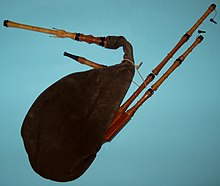Hümmelchen
The Hümmelchen is a bagpipe with a cylindrical inner bore, which appeared for the first time in the Renaissance and was described by Michael Praetorius in the Syntagma musicum .
Historic Hümmelchen
Praetorius describes the Hümmelchen as an instrument with two drone pipes on f 1 and c 2 and a chanter with a range (h 1 ) c 2 d 2 e 2 -c 3 . The chanter of the instrument on the sting of the Theatrum instrumentorum has a length (without spout) of about 12 cm.
An instrument that corresponds to this description is in the Kunsthistorisches Museum in Vienna (inventory number 287). It comes from Ambras Castle in Tyrol, the exact origin can no longer be determined. The instrument consists of a chanter, wind sock, blow pipe and the lower part of two drones. The material of the pipes is ivory . The length of the chanter is analogous to the instrument representation in the Syntagma musicum 12.10 cm. The bore of the chanter is cylindrical, the diameter of the bore is between 3.55 and 3.65 mm. There are seven finger holes on the front and one thumb hole on the back.
A larger chanter was found in 1996 in the Uelvesbüller Koog during the excavation of a 17th century shipwreck. Its length is 19.8 cm, the lower diameter is 11 mm. The cylindrical inner bore is 3.6 mm. The instrument has seven finger holes in the front and one thumb hole. It is made of a hard dark wood. The metal reed sleeve is still there, as is the socket. The instrument was in very good condition when it was found. It was equipped with a new double reed, which made the keynote d 1 sound with all closed tone holes .
Praetorius also refers to the French bagpipe with bellows (panel XIII) as a “little bumblebee” in addition to the term “small bagpipe”.
Fingering tables for bagpipes are documented for the 16th century. Martin Agricola mentions in his Musica instrumentalis deudsch from 1529 that recorders and bagpipes have “eynerley need” in the handles. His table for the recorder in C is an open fingering with a fork grip on the fourth above the root note.
The musicologist Ralf Gehler does not rule out that Hümmelchen were also made with a simple reed. Together with a further inner bore, a greater volume could be achieved, which makes the instrument also suitable for dance accompaniment. 1619 a "Jummelken" is mentioned in a description of Blocksberg as a dance accompaniment.
Modern Hümmelchen
Modern Hümmelchen are mainly offered with a chanter in c 1 . There are also chanter in the sopranino register (f 1 ), alto register (f or g) and also in the tenor register (c). In addition to the open fingering with forked handle, open fingering without forked handle and chanter with half-closed fingering are also available. The number and pitch of the drone are very variable, instruments with more than 2 drones are also called "Dudey". Both double reeds and single reeds are used in drones. With larger chanter, up to two keys are made to expand the range upwards.
In contrast to many other bagpipes, the Hümmelchen is suitable for making music in smaller rooms due to its volume and sound characteristics, as is common in apartments. Compared to many other bagpipes, the Hümmelchen also needs a low blowing pressure with a low air flow . Because of these properties, special Hümmelchen are also offered as inexpensive bagpipes for beginners. In order to save costs, these entry-level instruments are usually kept optically simple, equipped with plastic parts instead of parts made of natural materials in uncritical places and only equipped with a drone, which can usually be tuned to at least two tones.
Word origin
The name "Hümmelcken" is documented in a Rostock court record in 1577. 1609 "Hümmelken or Dudey makers" are also mentioned in Rostock. The word “Hümmelchen” probably comes from the Low German word “hämeln, humeln”, which means “to cut”. Basically, the Hümmelchen is a “trimmed” bagpipe; this name is probably due to the fact that the Hümmelchen is at least optically a small version of the larger shepherd's pipe . Another interpretation of the word "Bumblebee" refers to the diminutive of "Bumblebee", as a sound component of the instrument is reminiscent of the flying noise of the bumblebee .
Dudey
The Dudey is a bagpipe, the construction of which is essentially the same as the Hümmelchen. In contrast to this, dudeys have three or four drones that are in a common drone stick. In the Syntagma musicum, Praetorius specifies the notes es 1 + b 1 + es 2 as the drone tuning, the chanter starts with es 2 . Common modern drones are either f 0 + c 1 + f 1 or c 0 + f 0 + c 1 with three drones, c 0 + f 0 + c 1 + f 1 with four drones , with the exception of the high f- Borduns have retuning devices. Often not all drones are used at the same time when playing.
The play of dudeys to accompany the singing is documented:
"A Dudey sounds much better / And when my boy does sing / a Reuter Liedt / a Reuter Liedt / this refreshes my mind"
literature
- Michael Praetorius : Syntagma musicum . Volume 2, 1619
Web links
Individual evidence
- ^ Ernst E. Schmidt: An ivory miniature bagpipe from Ambras Castle in Tyrol , in: The bagpipes in Europe , Munich 1996, pp. 53–56
- ↑ Martin Agricola: Musica instrumentalis deudsch , "The First Chapter"
- ↑ Ralf Gehler : " The ock came with the doodle sack ". In: The bagpipes in Europe , Munich 1996.
- ↑ Bagpipe maker Jürgen Ross accessed on December 4, 2018
- ↑ Bagpipe Workshop & Woodwind Atelier , accessed on December 4, 2018
- ↑ Ralf Gehler: Sackpfeifer, Bierfiedler, Stadtmusikanten , p. 136.





